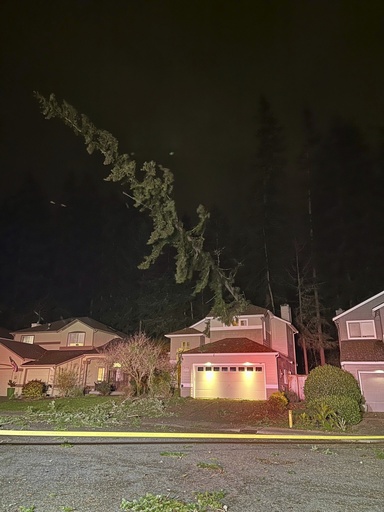SEATTLE — A significant storm system swept through the Pacific Northwest on Tuesday evening, unleashing powerful winds and heavy rainfall across the area. This severe weather event has led to widespread power outages and numerous instances of downed trees, resulting in at least one fatality.
The Weather Prediction Center alerted residents to potential risks of excessive rainfall expected to last until Friday, alongside warnings for hurricane-force winds as the region contends with what is being described as the strongest atmospheric river this season. This phenomenon, known as a “bomb cyclone,” occurs when a cyclone undergoes rapid intensification.
In Washington, fallen trees caused havoc, damaging homes and blocking roads. A tragedy struck in Lynnwood, where a woman lost her life when a large tree collapsed onto a homeless shelter, as reported by South County Fire. In Seattle, a tree fell onto a vehicle, trapping an individual temporarily inside. Fortunately, the Seattle Fire Department later confirmed that the person was in stable condition.
The Bellevue fire department also warned on social media about the numerous trees toppling across the city, advising residents to stay on the lowest floor and away from windows. They emphasized the importance of remaining indoors whenever possible during the storm.
By late Tuesday, reports indicated that over 450,000 homes were without power according to poweroutage.us, although this number fluctuated significantly, likely due to difficulties faced by various weather and utility services in reporting updates amid internet outages and other technical malfunctions. In addition to the outages in Washington, more than 15,000 households in Oregon and nearly 19,000 in California were left without electricity.
As of 8 p.m., maximum wind speeds were recorded in Canadian waters with gusts reaching 101 mph (163 kph) off the coast of Vancouver Island, per the National Weather Service in Seattle. Winds along the Oregon coast hit gusts of 79 mph (127 kph) during the evening, while Mount Rainier in Washington recorded gusts of 77 mph (124 kph). The weather service anticipated that winds would intensify across western Washington as the evening progressed.
The National Weather Service has issued warnings to the West Coast regarding the dangers posed by high winds on trees, advising individuals to avoid areas near exterior windows and rooms, in addition to exercising caution while driving.
In Northern California, flood and high wind watches were put into place, with predictions of up to 8 inches (20 centimeters) of rain in parts of the San Francisco Bay Area, North Coast, and Sacramento Valley. Officials warned of potential flash flooding, rock slides, and debris flows.
A winter storm watch also targeted the northern Sierra Nevada above 3,500 feet (1,066 meters), where up to 15 inches (28 centimeters) of snow may be expected over the following two days, with wind gusts in the mountain regions possibly exceeding 75 mph (120 kph), according to forecasters.
Furthermore, the National Weather Service has implemented a flood watch for specific areas in southwestern Oregon, which will remain in effect until Friday evening. Elevated winds and rough seas also disrupted a ferry service in northwestern Washington between Port Townsend and Coupeville.
A blizzard warning is currently in effect for much of the Cascades in Washington, including Mount Rainier National Park, effective from Tuesday afternoon, with forecasts predicting up to a foot of snow along with wind gusts that could reach 60 mph (97 kph). Travel across mountain passes is likely to be extremely challenging, if not impossible.
